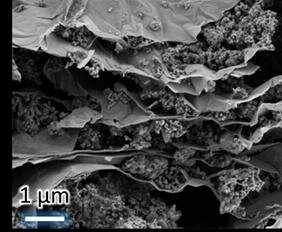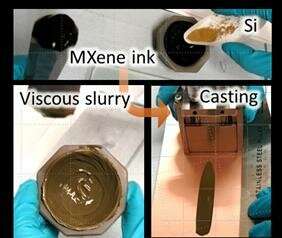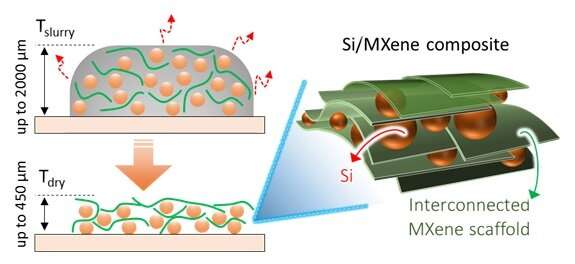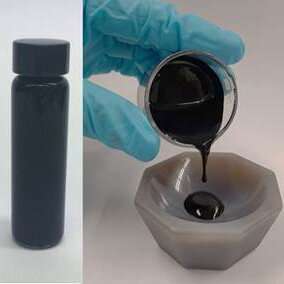Expanding the use of silicon in batteries, by preventing electrodes from expanding

The latest lithium-ion batteries on the market are likely to extend the charge-to-charge life of phones and electric cars by as much as 40 percent. This leap forward, which comes after more than a decade of incremental improvements, is happening because developers replaced the battery's graphite anode with one made from silicon. Research from Drexel University and Trinity College in Ireland now suggests that an even greater improvement could be in line if the silicon is fortified with a special type of material called MXene.
This adjustment could extend the life of Li-ion batteries as much as five times, the group recently reported in Nature Communications. It's possible because of the two-dimensional MXene material's ability to prevent the silicon anode from expanding to its breaking point during charging—a problem that's prevented its use for some time.
"Silicon anodes are projected to replace graphite anodes in Li-ion batteries with a huge impact on the amount of energy stored," said Yury Gogotsi, Ph.D., Distinguished University and Bach Professor in Drexel's College of Engineering and director of the A.J. Drexel Nanomaterials Institute in the Department of Materials Science and Engineering, who was a co-author of the research. "We've discovered adding MXene materials to the silicon anodes can stabilize them enough to actually be used in batteries."
In batteries, charge is held in electrodes—the cathode and anode—and delivered to our devices as ions travel from anode to cathode. The ions return to the anode when the battery is recharged. Battery life has steadily been increased by finding ways to improve the electrodes' ability to send and receive more ions. Substituting silicon for graphite as the primary material in the Li-ion anode would improve its capacity for taking in ions because each silicon atom can accept up to four lithium ions, while in graphite anodes, six carbon atoms take in just one lithium. But as it charges, silicon also expands—as much as 300 percent—which can cause it to break and the battery to malfunction.

Most solutions to this problem have involved adding carbon materials and polymer binders to create a framework to contain the silicon. The process for doing it, according to Gogotsi, is complex and carbon contributes little to charge storage by the battery.
By contrast, the Drexel and Trinity group's method mixes silicon powder into a MXene solution to create a hybrid silicon-MXene anode. MXene nanosheets distribute randomly and form a continuous network while wrapping around the silicon particles, thus acting as conductive additive and binder at the same time. It's the MXene framework that also imposes order on ions as they arrive and prevents the anode from expanding.
"MXenes are the key to helping silicon reach its potential in batteries," Gogotsi said. "Because MXenes are two-dimensional materials, there is more room for the ions in the anode and they can move more quickly into it—thus improving both capacity and conductivity of the electrode. They also have excellent mechanical strength, so silicon-MXene anodes are also quite durable up to 450 microns thickness."

MXenes, which were first discovered at Drexel in 2011, are made by chemically etching a layered ceramic material called a MAX phase, to remove a set of chemically-related layers, leaving a stack of two-dimensional flakes. Researchers have produced more than 30 types of MXene to date, each with a slightly different set of properties. The group selected two of them to make the silicon-MXene anodes tested for the paper: titanium carbide and titanium carbonitride. They also tested battery anodes made from graphene-wrapped silicon nanoparticles.
All three anode samples showed higher lithium-ion capacity than current graphite or silicon-carbon anodes used in Li-ion batteries and superior conductivity—on the order of 100 to 1,000 times higher than conventional silicon anodes, when MXene is added.
"The continuous network of MXene nanosheets not only provides sufficient electrical conductivity and free space for accommodating the volume change but also well resolves the mechanical instability of Si," they write. "Therefore, the combination of viscous MXene ink and high-capacity Si demonstrated here offers a powerful technique to construct advanced nanostructures with exceptional performance."

Chuanfang Zhang, Ph.D., a post-doctoral researcher at Trinity and lead author of the study, also notes that the production of the MXene anodes, by slurry-casting, is easily scalable for mass production of anodes of any size, which means they could make their way into batteries that power just about any of our devices.
"Considering that more than 30 MXenes are already reported, with more predicted to exist, there is certainly much room for further improving the electrochemical performance of battery electrodes by utilizing other materials from the large MXene family," he said.
More information: Chuanfang Zhang et al, High capacity silicon anodes enabled by MXene viscous aqueous ink, Nature Communications (2019). DOI: 10.1038/s41467-019-08383-y

















